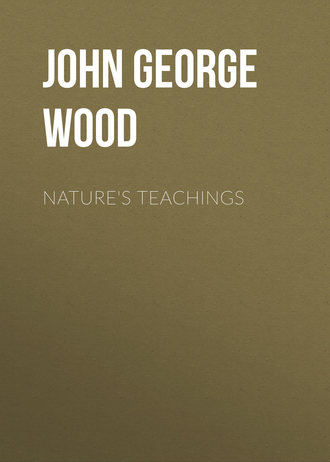 полная версия
полная версияNature's Teachings
An exactly similar spring is used in the well-known “Needle-gun,” the spring driving a needle through the explosive mixture, and so igniting the charge.
Our brass instruments would be very badly off without the spiral spring, which is placed under the pistons. The elasticity allows the pistons to be pressed down, and when the fingers are raised the pistons spring up again.
Another form of this instrument is seen on the right of the ordinary spring. This is used in the manufacture of spring mattresses and couches, and is made thinner in the centre, so as to allow of greater elasticity.
Below them is the spring which is used for watches and clocks, one end being fastened to the rim of the barrel, and the other to the pivot. When the latter is turned the spring becomes “wound up,” and, when released, keeps the works going by pressing against them. Of the “pall-and-ratchet” wheel, by which the movements are retarded, we shall treat in another place.
On the left hand of the illustration are a few figures of the Spiral Spring as seen in Nature.
On the extreme left of the group is a spiral cell taken from the flower-stem of the Water-lily. As the reader will see, it is composed of a number of fibres laid parallel to each other, and twisted into a hollow spiral. In order to exhibit its shape the better, the spiral has been partially uncoiled.
On the extreme right is a corresponding spiral cell from the common Lily, in which the spring power is given by two fibres twisted in opposite directions. The reader will now understand and admire the mechanism by which these plants attain their great strength and elasticity, the stems being made of myriads of these spiral fibres.
The oval body on the upper part of the illustration is a poison-cell of a marine polyp, and is given here as an example of an animal spiral spring, the others all belonging to the vegetable world.
We shall see more of its structure a little further on, and will not now examine it in detail.
The two remaining figures represent the remarkable objects called Antherozoids, i.e. the living creatures of anthers. They exist in vast numbers in the non-flowering plants, and inhabit those parts which correspond with the anthers of the flowering plants. When placed in water they have a curious way of coiling and twisting themselves spirally, so as to make their way through the water in a tortuous, but tolerably rapid, course. This movement is effected by the contraction and expansion of the spirally twisted filament. The upper figure represents a group of Antherozoids in their cells, and the lower is a much more magnified figure of a single Antherozoid as it appears when free, and in the act of moving through the water.
On the accompanying illustration are many examples of Spiral Springs, both natural and artificial. We will take these in their order.
The upper left-hand figure represents the “Buffer,” by which the carriages of railway trains are prevented from jarring against each other.
Perhaps some of my readers may be old enough to remember the days of the old railway carriages that were connected by short chains, and furnished with buffers that were merely padded. As the train started a separate jerk was given to every carriage by the tightening of the chains, and, as it stopped, all the carriages bumped against each other in a most unpleasant manner. Now, however, the buffers are furnished with powerful springs, and are pressed strongly against each other by means of screw-bolts, so that they form one continuous line.
In fact—and here is another analogy between Art and Nature—a train, when properly made up, bears a close resemblance to a human spine, the carriages being analogous to the vertebræ, and the spring buffers to the elastic cartilages between the vertebræ.
Nowadays, owing to this arrangement, the whole train moves together, and can be started and stopped so gently that the passengers are hardly aware of movement or stoppage. For example, one of my friends was in a train which came into collision with some obstacle. The carriages in front were dashed to pieces, and several of the passengers killed. His carriage, however, which was nearly at the end of the train, and had the benefit of all the springs, was hardly shaken, and the inmates did not know for some little time that an accident had occurred.
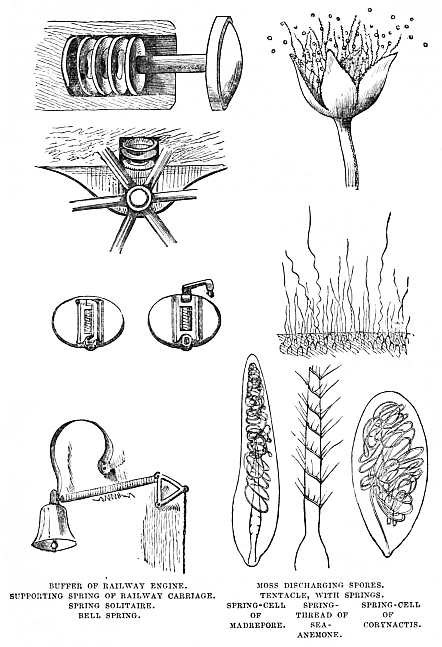
Below the buffer is a Wheel Spring, made exactly on the same principle, but set perpendicularly instead of horizontally.
The two figures beneath the wheel spring represent an object very familiar to us, namely, a Spring Solitaire, one figure showing it as open, and the other as closed. In this article the clasp is held in its place by a spring, and is only released by pressure.
Below the solitaire is a very prosaic application of the Spiral Spring, namely, that by which a house-bell is kept in vibration after the force of the pull has ceased, and which renders the bell, as Dickens happily remarks, so greedy to ring after it has been pulled.
I made and employed a spring of a similar character in closing the door of my parrot’s cage. Polly is a wonderfully clever bird, and a capital talker. First, she had a cage with upright bars, two of which could be slid upwards by way of a door. She soon found out the trick of the bars, and used to escape, carefully replacing the bars afterwards.
When she was transferred to a metal cage, she discovered that the door slid upwards, and began at her old tricks. So I took a piece of galvanised iron wire, coiled it into a spiral spring, fastened one end to the upper part of the door, and the other by a hook to a staple at the bottom of the cage. Consequently, when Polly lifted the door, and loosened her grip for a fresh hold, the door closed itself again. So, after awhile, Polly gave up the door, and now never tries to open it.
Passing to the upper right-hand corner of the illustration, there is shown a portion of Moss as it appears when magnified, and discharging its spores. When they are ripe a vast number of little spiral springs are let loose, and shoot the sporules into the air.
Below the moss are four figures, which are, in fact, the same object differently magnified, and seen from different points of view. These peculiar organs are technically termed “cnidæ,” from a Greek word which signifies a nettle. The appropriateness of the name we shall presently see.
I have already mentioned that the tentacles of various marine animals are furnished with poison-cells. The object of these cells is to capture and kill the prey, and the mode of doing so is very remarkable.
On the right and left of the illustration are two such bodies, in which is seen a sort of elastic wire coiled spirally, apparently without regularity, but really possessing a most beautiful order. That on the left is the poison-cell of a Madrepore, and the other is the same organ in a Corynactis. No sooner is the tentacle touched than the poison-cells are mechanically acted upon. They are turned inside out, and the coiled spring darts forth with wonderful violence.
Slight as is the dart, so fine that it cannot be seen except with the aid of a tolerably powerful microscope, it is a terrible weapon. Although it is projected with sufficient force to bury itself to its base even through so tough an object as the human skin, it could inflict but little injury, and would, indeed, scarcely be felt. But it carries with it a most irritant poison, which is apparently contained in the little capsule. These cnidæ are very plentiful in the tentacles of the Stinging Jelly-fish, or Stanger, as it is often called, and are charged with a terrible poison.
As is the case with all such poisons, its effects differ according to the constitution of the being that is poisoned. There are some persons, for example, who care no more for the sting of a bee than for the prick of a needle, and there are those whom a single bee-sting will bring almost to the gates of death. So with the tentacles of the Stinging Jelly-fish and those of the Portuguese Man-of-war, and there are persons who are scarcely affected with the sting of the scorpion.
So it is with nettles. When I was a boy at school it was thought necessary to wear an oak-leaf, or at least a portion of an oak-leaf, on the 29th of May, and all who did not possess this talisman might be flogged with nettles by those who did. As the school was situated in the north of England, where the oak puts forth its leaves late in the season, it was no easy matter to obtain a veritable oak-leaf, and we used to take any leaf that we could procure, and cut it round the edges into the similitude of a suitable oak-leaf.
The effect of the nettles upon the boys was most curiously diversified. Some cared nothing whatever for them; others suffered sharp but brief pangs; while others, of whom I was one, endured the most lancinating pain at the time, and for hours afterwards a hot, burning, fevered skin, and a heavy, dull ache, accompanied by throbbings of the brain so violent that it appeared as if the head would burst asunder at every heart-beat.
The fact of this inequality has been throughout life a valuable lesson to me, i.e. that a punishment which will nearly, if not quite, kill one man, will be no punishment at all to another.
Of course I cannot answer for the effects of these very minute cnidæ upon others, but I can state that they nearly killed me, and that if I had been forced to swim another hundred yards, I should have collapsed, sunk, and had a coroner’s jury return a verdict of “Found drowned in consequence of cramp.”
On me the effects were as follows:—First a slight, and then a severe, tingling on the parts which had been struck. Then sharp, darting pangs. Then a sudden shock as if a bullet had passed through the breast from one side to the other. Consequent collapse, and suspension of the office of both heart and lungs. I once had to walk nearly two miles after being stung by one of these dread animals, and how often I fell before reaching my lodgings I dare not say, but certainly once in every two hundred yards.
Even after partial recovery I should not have known my own face. It was that of an old and wearied man of seventy, grey, wrinkled, and withered; and many months elapsed before I felt myself sure that the weird-like bullet would not drive through my breast, and leave me lying on the ground gasping and speechless.
These dreaded tentacles can sting as fiercely when separated from the animal as when they are conjoined to it, as I can also testify from personal experience.
I have a natural alacrity in damaging myself, and there is scarcely a representative bone in the body that I have not fractured or dislocated, or both. Fortunately the cerebral vertebræ have hitherto escaped. I have broken the right leg, right arm, two ribs, and right collar-bone; dislocated the right ankle, and smashed nearly every bone of the right hand. At present, the damage to the left side is restricted to two ribs; and I hope that the Genius of Ossifraction may now be content with his work.
But I equally seem to have a natural affinity for the tentacles of the Stangers, which deliver their envenomed darts just as fiercely when they are separated from the Medusa as when they are connected with it.
A curious example of this fact befell me in the present year (1875). Seeing that there had been a steady southern gale, which made Lundy Island and Hartland and Baggy Points indiscernible, I dreaded my old foes, and, instead of bathing from the “Pebble Ridge,” took to the great “Nassau” Baths at Westward Ho. I sadly missed the roll of the waves, and the placid rapture of lying with outspread arms as the vast Atlantic billows came rolling in, flinging up the great grey boulders as if they were corks, and letting them roll down the ridge again with a thundering, and yet soothing, sound. Three miles or more inland may the thunder of the Pebble Ridge be heard; and at night, even though a storm be raging, tearing the leaves off the trees in whirling showers, flinging great branches into the air like ostrich plumes, and howling so that one person can hardly hear another speak, the dull, low, continuous thunder of the Pebble Ridge is heard over all. I have often remained awake at Bideford, simply on account of the deep roar of the Pebble Ridge, as the rising tide rolled its vast waves along the coast from Baggy Point, through Westward Ho and Clovelly, to Hartland.
When there is a heavy sea, the “undertow” of these waves is so great that even had no such things as Stangers existed, I should not have ventured upon the Pebble Ridge. One of my friends, a strong swimmer, was nearly drowned off that ridge by the undertow; and not long before I visited Westward Ho a promising young man lost his life within a few yards of that treacherous shore.
Much against my will, I went to the new bath, which is always supplied with a running current of sea-water; and I had hardly swum the length of the bath before I felt the familiar nettle-like sting in my foot. Fortunately it was only caused by a small fragment of a Stanger’s tentacle, which had been severed from the animal and pumped into the bath, and no harm ensued.
CHAPTER VI.
SPIRAL AND RINGED TISSUES.—VARIOUS SPRINGS IN NATURE AND ART
Spiral Tissues, and their Structure and Uses.—The movable Gas-lamp.—Elastic Tubes.—Breathing-tubes of Insects, and their Spiral Wire.—Ringed Tissues and their varied Structure.—Ringed Tissues applied to modern Dress.—Chinese and Japanese Lanterns.—Proboscis of the House-fly.—Trachea of various Animals.—Mutual Tendency of Rings and Spirals towards each other.—Fibres of the Yew-tree.—Diving and Divers.—Principle of the Diving-bell.—How it is supplied with Air.—Structure of the Air-tubes.—Nests of the Water-spider.—Diving by means of Tubes.—Larva of the Drone-fly, and its Mode of breathing.—How to examine them.—Leaping Springs.—The Skip-jack in Nature and Art.—Skip-jack or Click Beetles.—The Spring-tail, Grasshopper, Kangaroo, Gerboa, and other Jumping Creatures.
Spiral and Ringed TissuesWE have now to consider the Spiral Tissue under another aspect, i.e. that of acting as the internal support of an exterior membrane. Ringed tissues are necessarily conjoined with the Spiral, as they both discharge the same office, and in some cases merge almost imperceptibly into each other in the same specimens. This is most beautifully shown in the proboscis of the common House-fly, to which reference will presently be made.
The subject is so large that only a comparatively small selection of examples can be made, the greater number belonging to Nature, and not to Art.
We will first take the common movable Gas-lamp, with its accompanying tube. It is at present the tube of which we have to treat, the gas itself being reserved for a future page.
It is necessary that, in order to enable the lamp to be moved from one spot to another, the tube through which the gas passes must be so constructed that if it be bent, or even coiled, it retains its form, and does not become flattened. In order to obtain this object, a very long thin wire is coiled spirally to a suitable length. Over this wire is sewn the casing of the tube, which is afterwards made waterproof with elastic varnish. A still simpler mode is by enclosing a spiral wire within a tube of vulcanised india-rubber. It will be seen, then, that by the elasticity of the spiral wire the tube must always retain its shape, no matter how much it may be bent.
On the right hand of the illustration are shown the movable Gas-lamp and tube, and a portion of the latter is given with its spiral wire partially unwound, in order to show its structure.
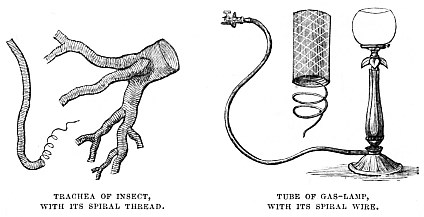
The large tubes which convey air to divers are made in the same manner, as they would not only succumb to the pressure of the water without the wire, but could not be dragged over obstacles or round corners without collapsing. It often happens that a diver is obliged, when surveying a sunken ship, to traverse the whole of her interior, descending ladder after ladder, and entering every cabin in the ship. This could not be done but for the internal coil of wire within the tube. Reference will presently be made to the subject of diving.
On the left hand is seen an object that looks something like a branch hollowed very thin. It is a magnified view of part of the Trachea or breathing-tube through which air is conveyed into the system of an insect. These breathing-tubes ramify to every portion of the body of an insect, even penetrating to the extremities of the antennæ, the wings, and the legs. It is obvious that as these organs are in tolerably constant movement, and the legs are much bent at every joint by the action of walking, the air-tubes which run through them must possess the same qualities as those of the gas-lamp and diver.
If one of these tracheæ be removed and placed under the microscope, it will be seen to be constructed in a manner exactly similar to that which has been described. Within the membrane which forms the tube proper there is a very fine, but very strong thread, which is coiled exactly like the wire spring. It is not attached to the membrane, and so strong is it that, although it is all but invisible to the naked eye, it can be drawn out as shown in the left-hand figure of the illustration. If laid on a piece of glass, it immediately tries to recoil itself, and for some little time will twist and curl about as if it were alive.
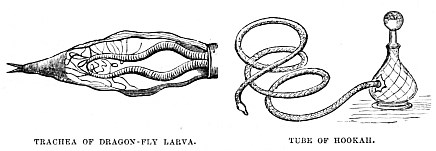
On the above illustration are two similar examples of the spiral thread with a flexible tube. The right-hand figure represents one of the many forms of the water-pipe, whether known as Hookah, Narghile, or Hubble-bubble. In the simpler forms of this pipe, such as the latter, the inhaling-tube is quite straight, and the bowl is held in the hands of the smoker. In the more refined pipe, however, the tube is very long, flexible, and made elastic by an inner spiral wire.
Perhaps the reader may remember that the larva of the Dragon-fly is a most remarkable creature in consequence of its methods of propulsion and respiration. The water is taken into the interior of the body through a peculiarly formed aperture, and then ejected with such violence as to drive the body forward on the same principle as that which causes a rocket to ascend.
The figure on the left hand of the illustration is a representation of the abdomen of this larva rather magnified, and opened so as to show the interior. On either side run the two principal breathing-tubes, through the delicate membranes of which the spiral thread can plainly be seen.
These tubes are connected with a smaller set, and they with a still smaller, so that at last they are of such tenuity that they can scarcely be distinguished without the use of a glass. But, however small they may be, they are always fitted with the spiral thread.
We now come to the cases where the membrane is supported by a series of rings, and not by a single spiral wire.
In the right-hand division of the illustration are two specimens of objects which shall be nameless, but which were drawn per special favour at a milliner’s shop. Although the day has now happily gone by when the larger object was in general wear, and seemed to be irrepressively increasing in dimensions, certain modifications of it, under various names, have made their appearance in almost every book of fashions and every large milliner’s shop.
Here we have the external membrane made of linen, calico, merino, or similar material, distended by a number of elastic rings set at tolerably even distances from each other.
The two small objects represent the handy little paper lanterns so common in China and Japan. They are composed of an external coat of tough tissue paper, so thin that it allows the light to pass through it with tolerable freedom, and of an internal series of elastic rings, which not only support it and preserve its cylindrical shape, but allow it to be folded up flat when not wanted.
I possess a singularly ingenious lantern of this kind, made in Japan, and displaying the thoroughness of work which characterizes that nation. It is five inches in diameter, and the lantern itself is affixed at either end to a circular wooden cap the upper fitting over the lower. Consequently, when the lantern is shut, it is entirely enclosed between these two caps, which effectually preserve it from harm. It is delicately finished, and has no less than thirty rings, made of very narrow strips of bamboo. The upper cap has a little trap-door through which the candle can be admitted and trimmed, and in its centre is a small round hole for the passage of air.
In the left-hand division of the illustration are shown several examples of ringed and spiral tissues belonging to the vegetable world, in which the principle is exactly the same as that of the Chinese lantern, &c. That on the right hand is an example of simple rings within a membrane. The central figure shows a double spiral, which produces very much the appearance of a series of rings; and on the extreme left is an interesting example which shows the transition in the internal supports from spirals to rings.
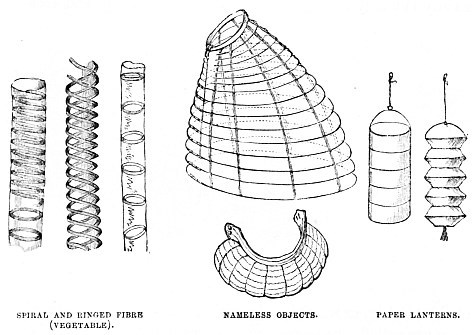
I have already mentioned that the proboscis of the House-fly exhibits this modification. If one of these objects be placed under a moderate power microscope—the half-inch is quite enough—and examined, it will be seen that there are some large tracheæ, just like those of the Dragon-fly larva, on each side of the proboscis, and that, where the end is widened and flattened into a sort of disc, their place is taken by a set of very much smaller tracheæ, coming nearly to a point, and each being supported internally by a series of incomplete rings, shaped very much like the letter C. A slide containing this object well mounted can be purchased at any optician’s for a shilling.
The trachea, or windpipe, as we call it, of all vertebrate animals, man included, is formed on exactly the same principle, as any one may see by going to a butcher’s shop, and looking at the trachea, or windpipe, by which the lungs, or “lights,” as they are called, are suspended. Were it not for this structure, we should not be able to bend our necks or turn our heads.
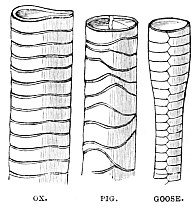
The accompanying illustration shows the tracheæ of three well-known creatures. The left-hand figure is the trachea of an Ox, the central figure that of a Pig, and the right-hand figure that of a Goose. Mr. Tuffen West, who made the drawings, sent with them the following remarks:—
“The tracheæ of animals furnish some very interesting examples of variation in the form and arrangement of the rings. Their purpose, perhaps, one can but guess at in some cases; but doubtless, as being works of the Master Builder, careful study would be repaid.
“In the Ox the rings are very strong and close, and in form like a horse-shoe with the ends approximated.
“In the Pig the incomplete rings are broad at one part, and narrow on the opposite side, with a tendency to spiral arrangement. I imagine that this would make a very rigid tube, and, indeed, it feels so in the hand.
“Then, in the Goose, the narrowed lower part is that which is figured just before the trachea reaches the sternum. The (complete) rings are twice as broad in one half as in the other, and by the alternate disposition of these differing widths, a tube is formed of great flexibility fore and aft, but almost absolutely rigid in the lateral direction. This seems to be so marked an evidence of design as to be calculated to greatly raise our admiration.”
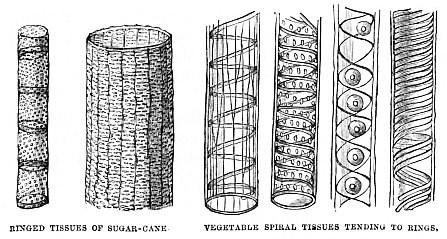
We have seen several examples of ringed tissues tending to the spiral form, and it is but natural that we should expect to find spiral tissues tending to the ring.
In the accompanying illustration the two left-hand figures represent the curiously modified ringed tissue which is to be found in the sugar-cane, the left-hand figure being much more magnified than the other.






